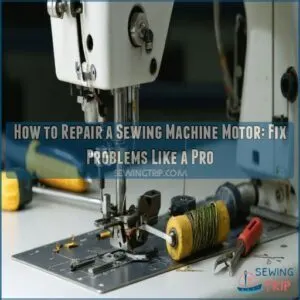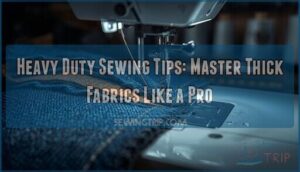This site is supported by our readers. We may earn a commission, at no cost to you, if you purchase through links.

Unplug the machine for safety, and gather tools like screwdrivers, needle-nose pliers, and a multimeter.
Inspect the carbon brushes; if they’re worn down, replace them. Check the wiring for breaks or frays, and test motor resistance with your multimeter. A faulty thermal protector? That too can be replaced.
Major issues like burnt coils, though, might need professional help.
Regular maintenance, like cleaning out lint and ensuring good airflow, can prevent future headaches—and keep that trusty motor humming along happily!
Table Of Contents
- Key Takeaways
- Sewing Machine Motor Basics
- Repairing a Sewing Machine Motor
- Common Problems and Troubleshooting
- Preventive Maintenance Tips
- Removing and Replacing a Sewing Machine Motor
- Choosing The Right Replacement Motor
- Motor Installation and Belt Selection
- Safety Precautions and Tools Needed
- Frequently Asked Questions (FAQs)
- Conclusion
Key Takeaways
- Identify the issue first by checking for worn brushes, damaged wiring, overheating, or unusual noises, and unplug the machine for safety.
- Replace worn carbon brushes, repair damaged wires, and clean out lint to prevent overheating and ensure smooth motor performance.
- Use a multimeter to test motor resistance and ensure proper electrical connections, tightening or replacing loose or faulty components.
- Consider professional help for major issues like burnt coils, but regular maintenance like cleaning, lubrication, and ventilation can prevent most motor problems.
Sewing Machine Motor Basics
In the context of sewing machine motors, understanding the basics can save you time and frustration.
Whether you’re dealing with a speedy servo motor or a powerful clutch motor, knowing how they work is the first step to fixing them like a pro.
Types of Sewing Machine Motors
Sewing machine motor types break down into two main categories: servo motors and clutch motors.
Servo motors focus on precision and efficiency, running quieter and cooler—perfect for smaller tasks.
Clutch motors, however, pack more power, though they’re noisier and less efficient.
Choosing between them depends on your project needs, desired motor lifespan, and whether noise levels matter during use.
Servo Motors Vs Clutch Motors
Picking between clutch motors and servo motors? Here’s the deal: clutch motors are louder, powerful workhorses but lack precision. Servo motors, on the other hand, are quiet, lightweight, and offer better speed accuracy. When choosing the right motor for your sewing machine, bear in mind the sewing motor clutch system.
- Noise levels: Servo motors are quieter, saving your ears.
- Motor lifespan: Servo motors often outlast clutch ones.
- Repair costs: Clutch motors may hit your wallet harder.
Motor Speed and Power
If you’ve ever felt your sewing machine motor was racing like a runaway train, it’s likely tied to speed consistency.
Proper motor speed control balances speed and power for efficiency.
A clutch motor offers raw power, while a servo delivers smoother control.
Check this breakdown:
| Motor Type | Power Efficiency | Noise Level |
|---|---|---|
| Servo | High | Low |
| Clutch | Moderate | High |
| Hybrid | Balanced | Moderate |
Repairing a Sewing Machine Motor
Fixing a sewing machine motor might sound tricky, but it’s often simpler than you think. Start by identifying the issue: is it overheating, inconsistent speed, or odd noises? Once pinpointed, get your tools ready—screwdrivers, needle-nose pliers, and a multimeter are your best friends here. If your Singer sewing machine motor requires professional rewiring, consider a mail-in motor rewiring service.
- Check out the carbon brushes; worn brushes are a common culprit.
- Inspect wiring for damage, replacing exposed wires with heat-shrink tubing.
- Use a multimeter to test resistance, ensuring it’s within the normal range.
Always unplug the machine before any repair work. And remember, while DIY repairs save on repair costs and boost your motor’s lifespan, tackling major issues like burnt coils may need a pro. Keep safety first!
Common Problems and Troubleshooting
When your sewing machine motor starts acting up, it can feel like it’s trying to ruin your creative streak.
Most problems, like overheating or weird noises, are easier to fix than you might think.
Overheating Issues
Overheating turns your sewing machine motor into a hot mess. Common overheating causes include lint buildup and running it too long without breaks. Prevention methods? Regular cleaning, proper lubrication, and cooling solutions like better ventilation.
Worried about repair costs? Replace damaged thermal protection before it spirals into bigger sewing machine motor problems. Stay proactive with motor maintenance.
Additionally, inspect for field coil insulation deterioration, which can also lead to overheating issues, and check out motor rewiring techniques.
| Problem | Cause | Solution |
|---|---|---|
| Excessive heat | Lint buildup | Regularly clean with compressed air |
| Motor feels hot quickly | Poor ventilation | Add cooling fans or space around it |
| Motor shuts down | Overuse | Take breaks during long sewing runs |
| Burnt smell or damage | Thermal protection failure | Replace thermal protector |
| Uneven speed or strain | Lack of lubrication | Apply motor-specific oil |
Power Loss and Inconsistent Speed
When your sewing machine motor won’t run like it should, check for worn carbon brushes or power cord issues.
A faulty speed controller or electrical wiring fault might also slow things down.
Sometimes a motor capacitor check reveals the culprit.
Sewing machine motor troubleshooting isn’t rocket science—tackle these sewing machine motor problems step by step, and regain smooth sewing control.
Unusual Noises and Bearing Issues
Strange noises from your sewing machine motor can point to faulty bearings.
Start with a noise diagnosis—spin the motor manually to identify squeaks or grinding.
Bearing lubrication might help, but if the noise persists, it’s time for motor replacement.
Regular sewing machine motor maintenance, like checking for wear, guarantees smoother stitching and prevents bigger issues later.
Stalling and Excessive Strain
If your sewing machine motor won’t run or keeps stalling, strain causes could be lurking in plain sight. Check these:
- Belt tension – Too loose or too tight can wreak havoc.
- Needle issues – A bent or dull needle might jam things up.
- Bobbin problems – Misaligned or tangled bobbins cause strain.
- Fabric type – Thick materials challenge weaker motors.
- Lack of maintenance – Regular sewing machine motor troubleshooting prevents stoppages.
Preventive Maintenance Tips
Taking care of your sewing machine motor doesn’t just save you headaches—it keeps your stitches smooth and your projects stress-free.
A little cleaning, oiling, and attention to details like airflow and connections can make all the difference.
Regular Cleaning and Lubrication
Dust and lint removal is step one for sewing machine motor care—grab a brush or compressed air.
For motor lubrication, stick to manufacturer-recommended sewing machine oil types and apply sparingly but regularly.
Sewing machine maintenance thrives on consistency, so set a frequency for cleaning sessions.
Preventative care like this keeps your motor running smoothly, whispering instead of whining.
Temperature Monitoring and Ventilation
After cleaning and lubrication, keep your motor cool by ensuring airflow solutions like proper ventilation.
Overheating prevention starts with checking vents for blockages—lint’s a sneaky culprit. Add fan upgrades or heat sinks for better results.
Coolant systems aren’t standard for sewing machines but maintaining airflow stops overheating headaches.
Temperature monitoring helps spot brewing issues during motor use, preventing costly repairs.
Monitoring patient temperature is also key in medical settings, like during general anesthesia care, to prevent complications.
Checking Electrical Connections
A quick power check saves headaches. Loose wires or faulty plugs often cause motor misfires.
Here’s your to-do list:
- Inspect power cords for damage—any frays? Replace them.
- Tighten loose connections with needle-nose pliers.
- Test outlets using a voltage tester to rule out supply issues.
- Use connection diagrams to spot faulty wiring before your sewing machine motor won’t run smoothly.
Proper maintenance like this can help prevent issues, especially with a sewing machine that has an automatic needle threader.
Removing and Replacing a Sewing Machine Motor
Taking out an old sewing machine motor and putting in a new one might sound tricky, but it’s easier than you’d think with the right steps.
Don’t worry—by the end, you’ll feel like a repair pro with a machine ready to sew like new!
Motor Removal Steps
Removing a sewing machine motor feels tricky, but it’s manageable with the right tools and a bit of patience.
Before starting, make certain you have the necessary motor repair parts.
Start by locating the screws securing the motor.
Loosen these, disconnect the wiring (refer to a wiring diagram), and remove the belt.
Here’s a quick guide:
| Step | Action |
|---|---|
| 1. Tools | Gather tools like screwdrivers |
| 2. Screws | Locate all motor screws |
| 3. Belt | Remove the drive belt |
| 4. Wires | Disconnect wires carefully |
| 5. Motor | Slide out the motor |
Installing a New Motor
Once the old motor’s out, position the new one carefully on the mounting bracket. Secure it snugly with the provided screws, making sure of proper alignment.
Don’t forget to reconnect the wiring correctly—refer to the manual if needed.
Before making any electrical connections, verify that the feed dogs maintenance is in good condition to prevent any issues.
With the motor mounted securely, you’re halfway there. Sewing machine motor installation doesn’t have to be intimidating—it’s methodical steps.
Adjusting Belt Tension
Getting the belt tension just right on your sewing machine motor is key.
Use belt tension tools to loosen the motor bracket screw, then adjust the motor height to tighten the belt.
Aim for smooth, slip-free motion without over-tightening. Test by hand-turning the wheel—no slipping, but no struggling either.
Fix tension issues before they unravel your sewing!
Improper belt tension can lead to motor coupler problems, such as when replacing a broken motor coupler on a Pfaff 262 sewing machine.
Choosing The Right Replacement Motor
Choosing the right replacement motor might feel a bit overwhelming, but it doesn’t have to be.
With a little guidance, you’ll pick a motor that’s reliable, responsive, and perfect for your sewing machine.
Alphasew and VGK Motor Options
Choosing between an Alphasew motor and a VGK motor boils down to priorities. The VGK motor often edges out with sturdier build quality and a slightly longer lifespan for a similar price. Alphasew motors, however, remain solid contenders.
- Price comparison: VGK offers more durability for the cost.
- Noise levels: Both are fairly quiet.
- Warranty details: Check specifics before buying.
Motor Amperage and Foot Pedal Responsiveness
Higher amperage improves sewing machine motor power but doesn’t always boost stitch quality.
For instance, a difference in motor amperage, such as the one found in the Janome HD3000 issue motor amperage discrepancy, can impact the motor’s performance.
For smooth pedal feel and motor control, match the motor’s specs to the pedal.
Responsiveness tests can catch mismatches early—like inconsistent sewing machine motor speed.
Watch for power surges or overheating; they’re hints you might need deeper troubleshooting tips to tackle compatibility issues.
Thorough Motor Inspection
Before you commit to a replacement, inspect the motor thoroughly like a pro.
- Visual inspection: Look for damaged wiring, worn brushes, or signs of overheating.
- Testing components: Use a multimeter to check connections and functionality.
- Shaft condition: Rotate it manually—smooth movement means fewer headaches later.
Also, pay close attention to the motor brushes condition, as excessive wear can be a common cause of motor issues.
Master this step, and sewing machine motor repair gets a lot smoother!
Motor Installation and Belt Selection
Getting the motor installed and belt properly selected might seem tricky, but it’s easier than you think with a few clear steps.
You’ll just need the right belt size, secure motor placement, and a little patience to get things running smoothly.
Selecting The Right Belt for Your Machine
Finding the right sewing machine belt matters for smooth stitching.
Start by measuring the belt size needed—this depends on your machine’s hand wheel type (solid or spoked).
Choose a belt material like rubber or leather, matching durability needs. Stick to trusted belt brands for reliability.
A proper fit guarantees belt tension stays steady, preventing hiccups during motor replacement or repair.
Installing a New Belt
Got your new belt ready? Start by checking the belt size and type to match your machine’s specs.
Next, carefully follow the belt routing path around the drive belt pulleys.
Verify that the belt tension feels just right—not too tight, not too loose. A snug fit keeps everything running smoothly.
Belt replacement costs little but guarantees sewing machine motor repair success!
Positioning and Securing The New Motor
Line up the new sewing machine motor with the mounting bracket.
Hold it steady as you thread the motor mounting screws into place – don’t overthink it, just aim for a secure fit.
Motor alignment matters, so double-check before tightening.
Once snug, adjust the belt tension to avoid slipping.
Proper screw tightness seals the deal on your sewing machine motor replacement.
Safety Precautions and Tools Needed
Before you tackle any motor repair, you’ll need the right tools.
safety to avoid mishaps.
Don’t worry—staying safe is straightforward when you follow a few simple rules and keep your workspace organized.
Essential Tools for Motor Repair
Once the motor’s positioned, you’ll need the right tools to tackle sewing machine motor repair. Stock up on these must-haves:
- Multimeter – Check electrical flow in motor parts easily, avoiding guesswork.
- Screwdrivers – Assorted sizes help reach tight spots.
- Needle-nose pliers – Great for gripping wires.
- Soldering iron – Fix connections with precision and smooth tips.
Before starting, consider the essential task of checking and replacing motor brushes replacement, as worn-out brushes can cause various motor issues.
Safety Equipment and Precautions
Before grabbing your sewing machine repair tools, put on eye protection—flying debris isn’t your friend.
Verify proper ventilation if lubrication or cleaning is involved.
Unplug for electrical safety and double-check wiring before testing.
Handle tools with care, like the sharp scalpels they resemble.
Keep a contingency plan handy because even pros need backup during DIY sewing machine repair adventures.
Seeking Professional Help
If your sewing machine motor won’t run or makes unusual noise, calling a pro can save time and headaches.
- Cost vs. DIY: Repairs might be cheaper than replacing parts yourself.
- Warranty claims: Check if repairs are covered.
- Finding experts: Search "sewing machine repair near me."
- Repair shop reviews: Read reviews to avoid shady shops.
Alternative Power Solutions
Don’t want to deal with replacing a motor? Try treadle sewing machines for a workout or hand crank options for old-school charm.
Battery-powered motors offer portability, while solar power sewing is for off-grid living.
Pedal alternatives or external motor replacements can modernize older machines.
A hand crank conversion adds versatility to your motorized sewing machine repair toolkit.
Consider DIY renewable energy sources like a homemade wind turbine to power your sewing machine.
Frequently Asked Questions (FAQs)
What are some common problems with a sewing machine motor?
Nearly 30% of sewing machine issues trace back to the motor.
You’ll face overheating, power loss, odd noises, or stalling, often from lint buildup, worn brushes, or strained bearings.
Regular cleaning keeps problems at bay.
How long does it take to replace a sewing machine motor?
Swapping out a sewing machine motor usually takes 30-60 minutes.
It depends on your experience, motor type, and machine design.
With basic tools and clear instructions, you’ll have it running smoothly before long!
How do you remove a motor from a sewing machine?
To remove a sewing machine motor, unplug the machine.
Access the motor by removing the belt cover.
Loosen the mounting screws, detach the drive belt, unscrew the motor, and carefully disconnect its wiring.
How do I know if my sewing machine has a motor problem?
You’ve got a motor problem if your sewing machine overheats, slows down, makes weird noises, or won’t start.
Watch for inconsistent speeds, burning smells, or excessive vibration—it’s like your machine’s way of crying for help!
What is a sewing machine motor?
Imagine this: a small but mighty engine humming smoothly as it powers your sewing creativity.
A sewing machine motor turns electricity into motion, driving the needle and creating stitches with precision, speed, and control.
How to repair a sewing machine?
Start by identifying the problem, like noise, skipped stitches, or uneven tension.
Clean lint, oil moving parts, and check the needle, thread, and belt.
For electrical issues or broken parts, professional help might be needed.
How do I know if my sewing machine motor is bad?
If your motor overheats, runs inconsistently, stalls under normal use, or makes loud, unusual noises, it’s likely bad.
Check for dust buildup, worn brushes, or wiring issues before considering replacement or professional repair.
Why is my sewing machine motor not working?
Your sewing machine motor mightn’t work due to worn brushes, loose wires, overheating, or clogged ventilation.
Check for obvious damage, odd noises, or burning smells.
Then clean, tighten connections, or replace faulty components as needed.
Is it worth repairing a sewing machine?
Fixing a sewing machine can feel like breathing new life into an old friend.
It’s worth it if repairs cost less than replacement.
and the machine holds sentimental value or delivers features newer models lack.
Can a sewing machine motor be reversed?
Yes, sewing machine motors can be reversed by switching the polarity of the motor’s wiring.
It’s a straightforward tweak, but double-check your machine’s manual or consult a pro if the wiring seems tricky.
Conclusion
Imagine your machine stalling mid-project—frustrating, right?
Knowing how to repair a sewing machine motor can save the day.
With steps like replacing worn carbon brushes, fixing damaged wires, or addressing overheating, you’ll feel empowered to tackle common issues.
Don’t forget preventive care like cleaning, ventilation, and checking connections to avoid future mishaps.
For bigger challenges, seek professional help or invest in a sturdy replacement motor. Keep that machine running smoothly and your creative projects unstoppable!















